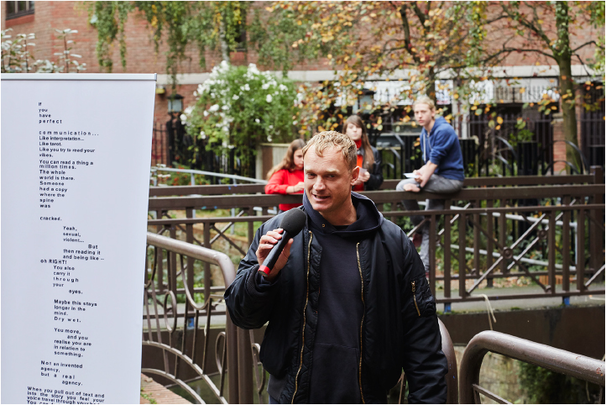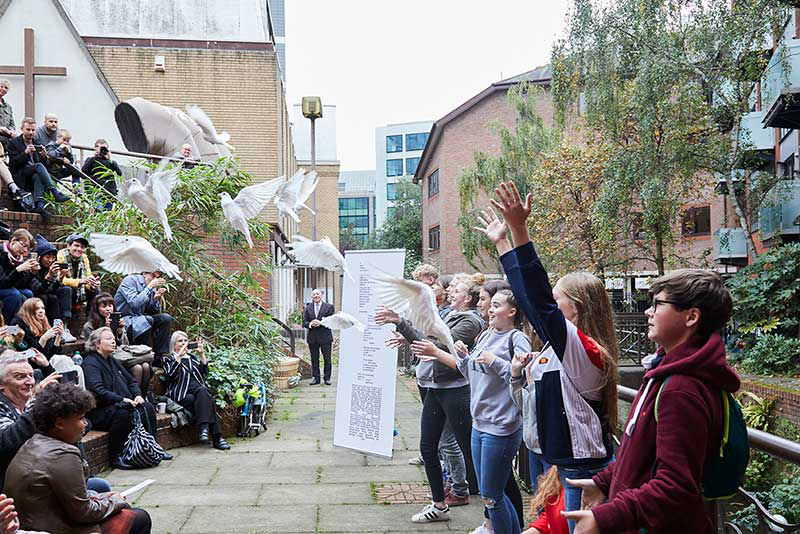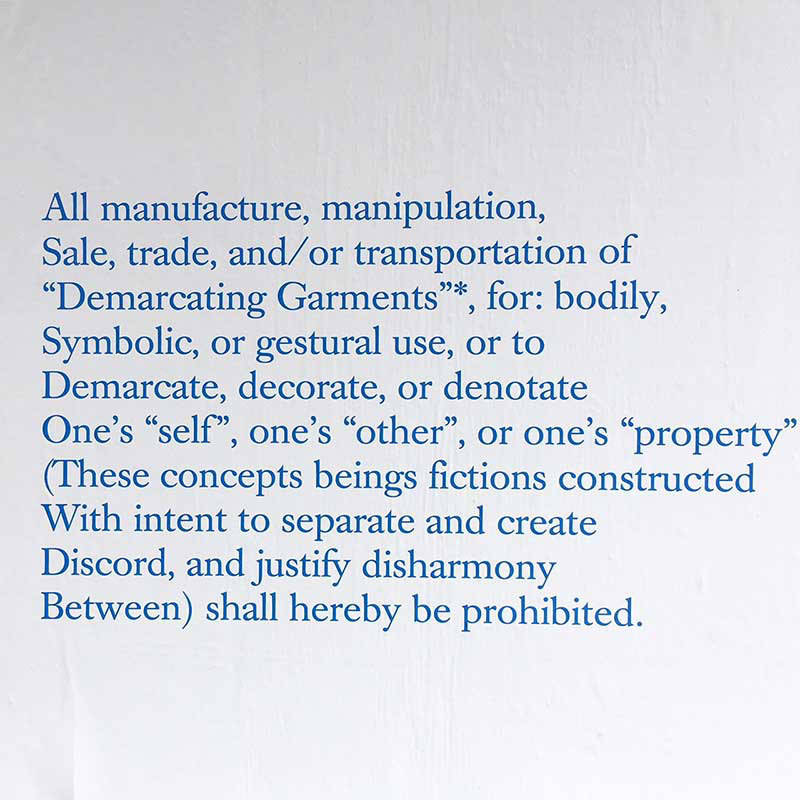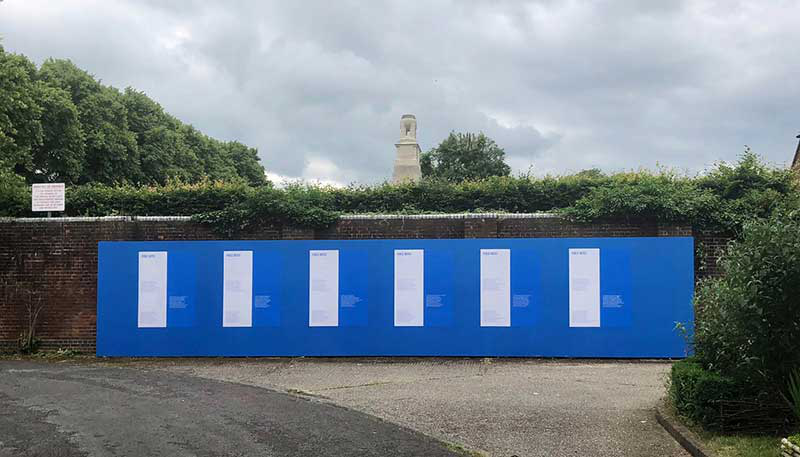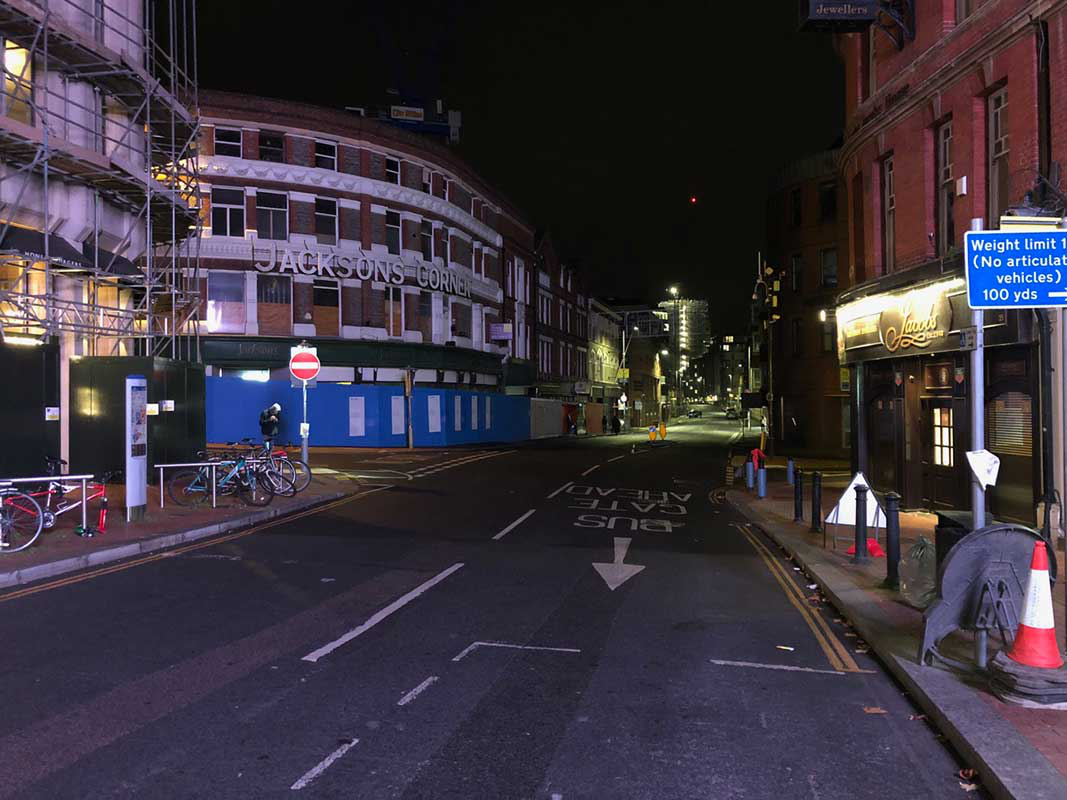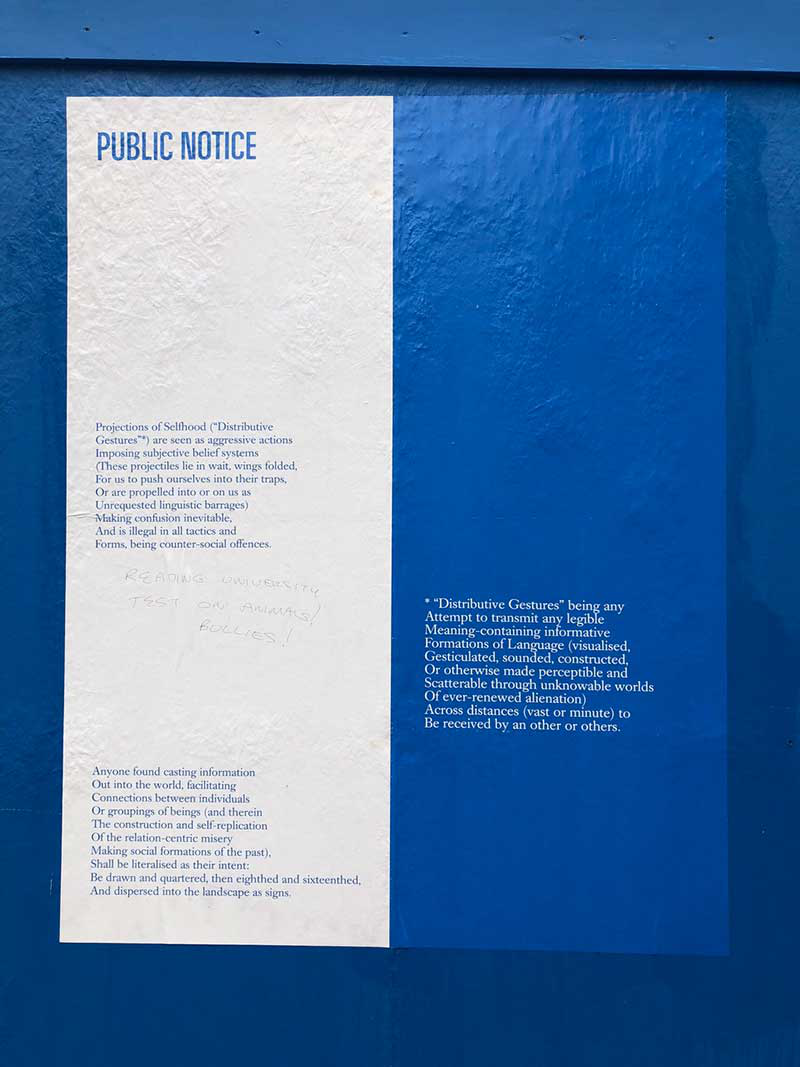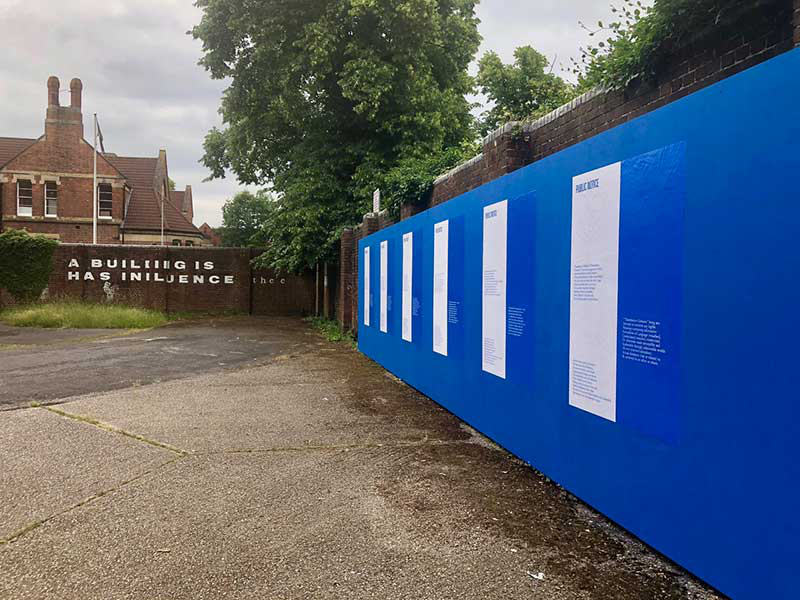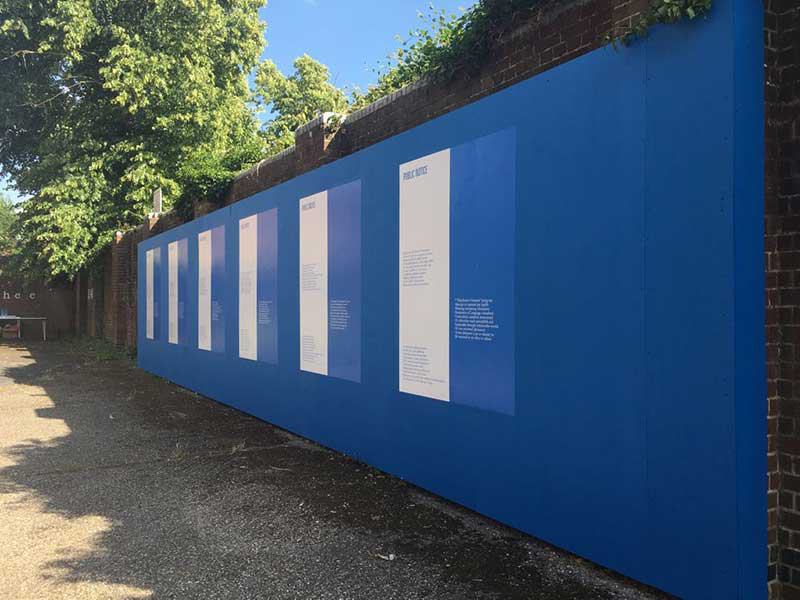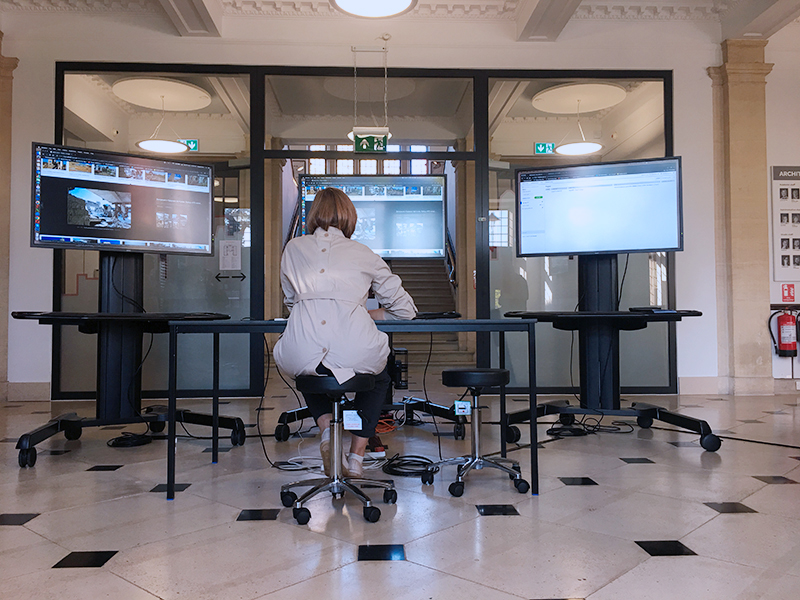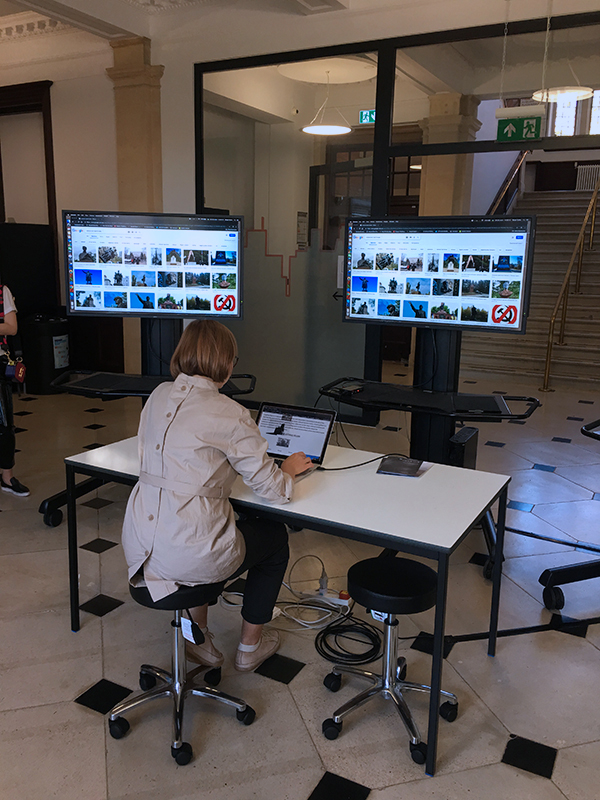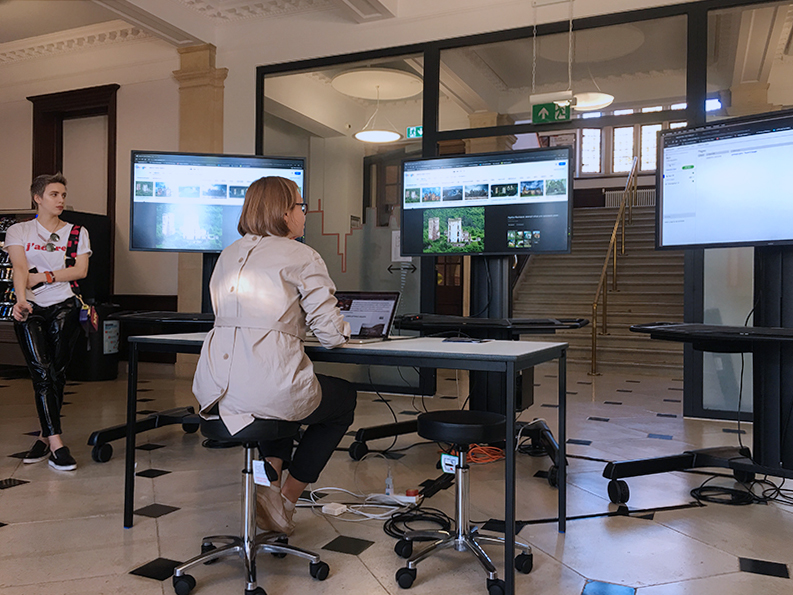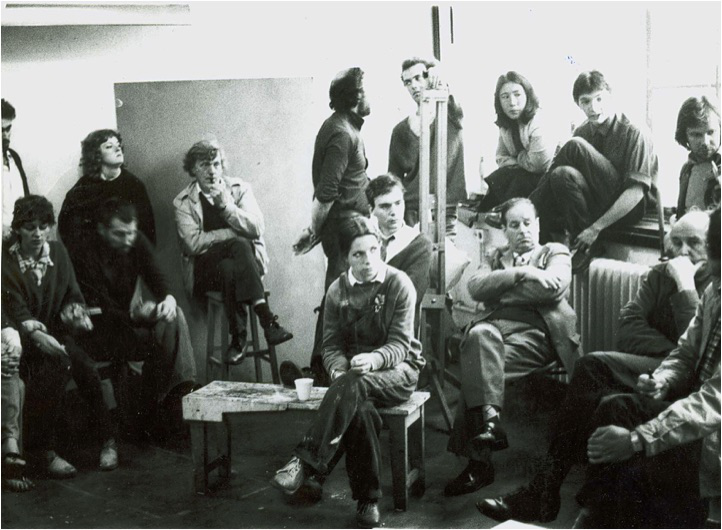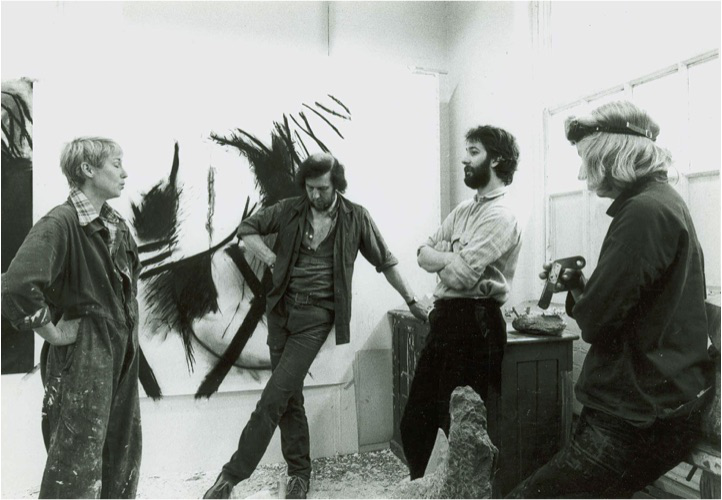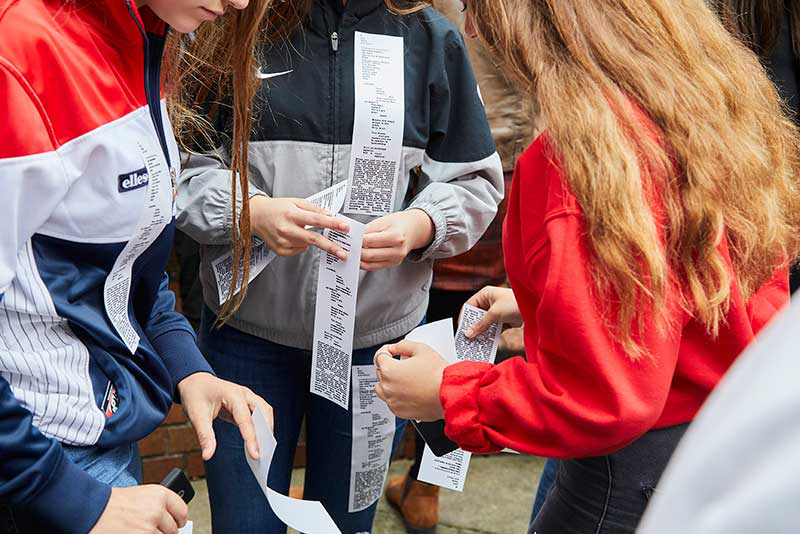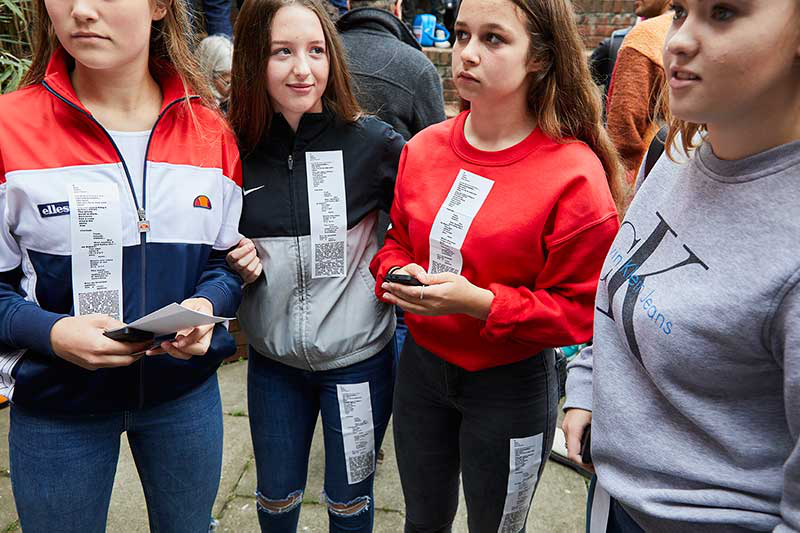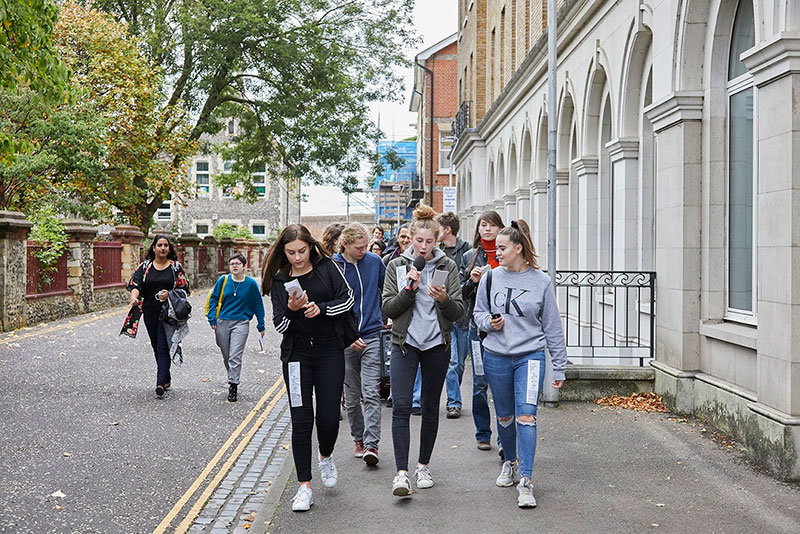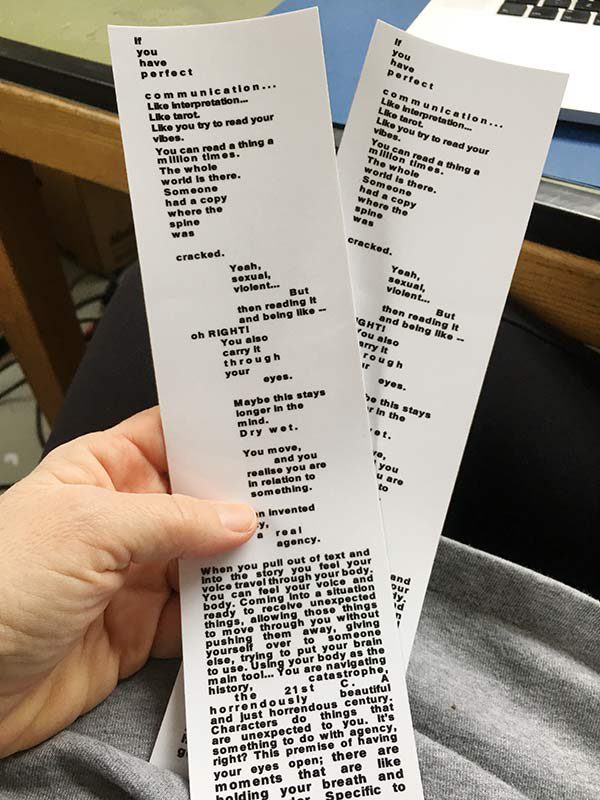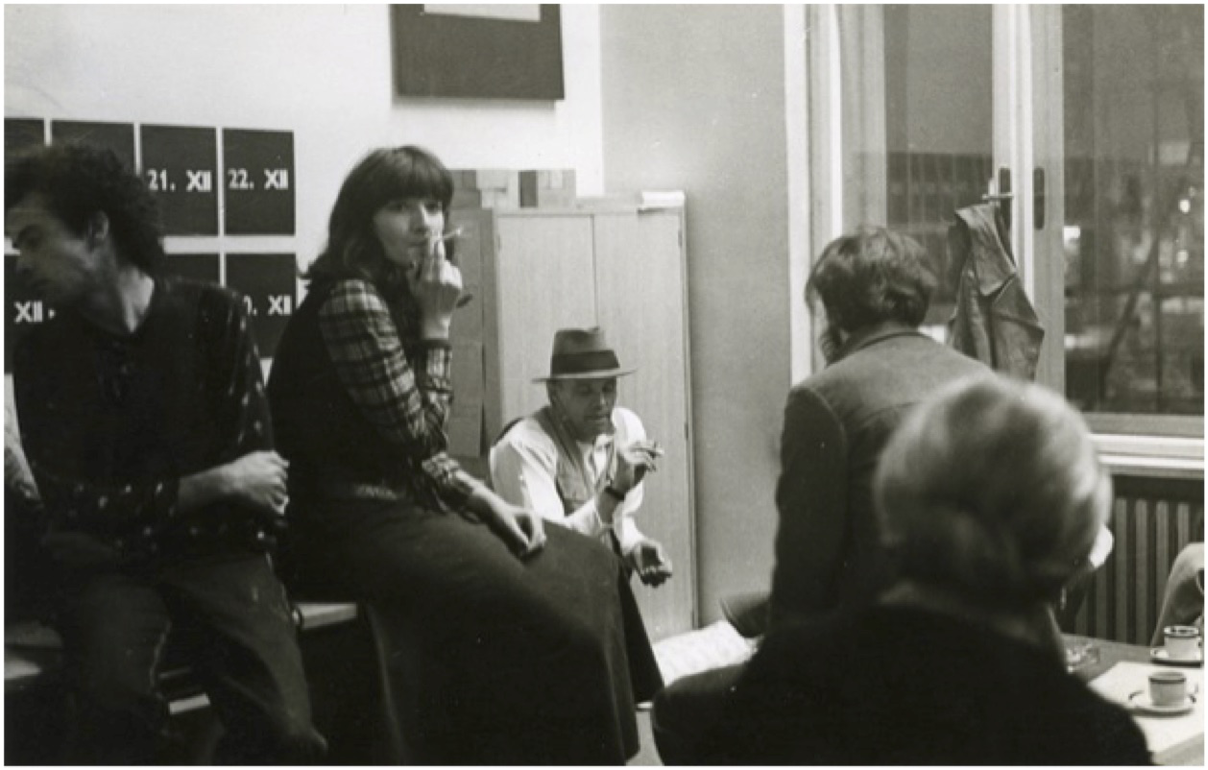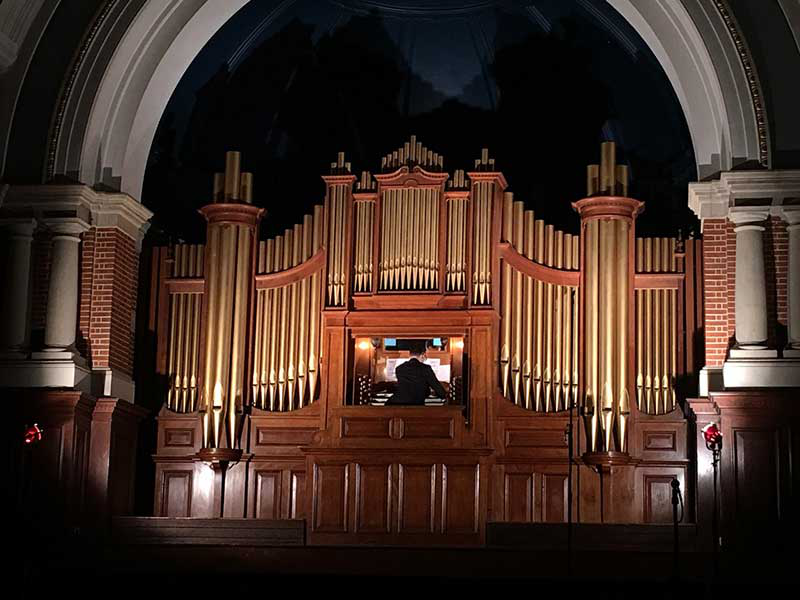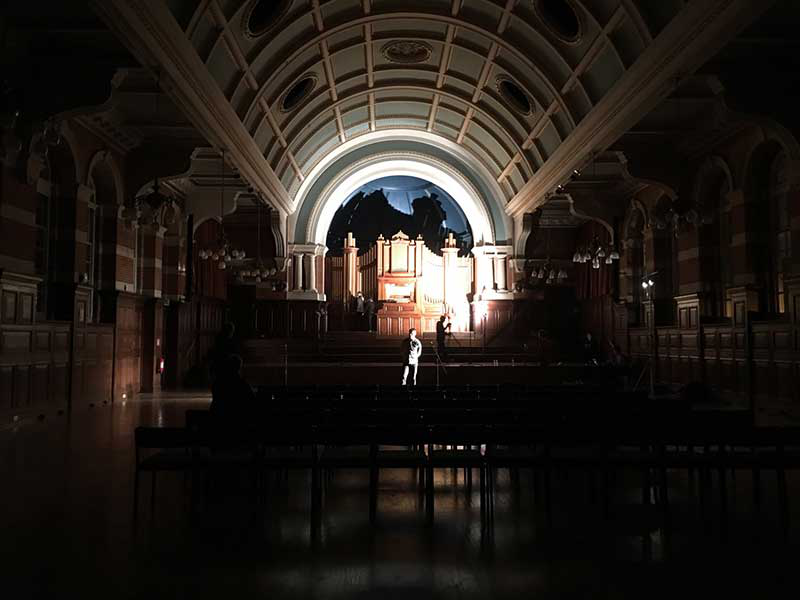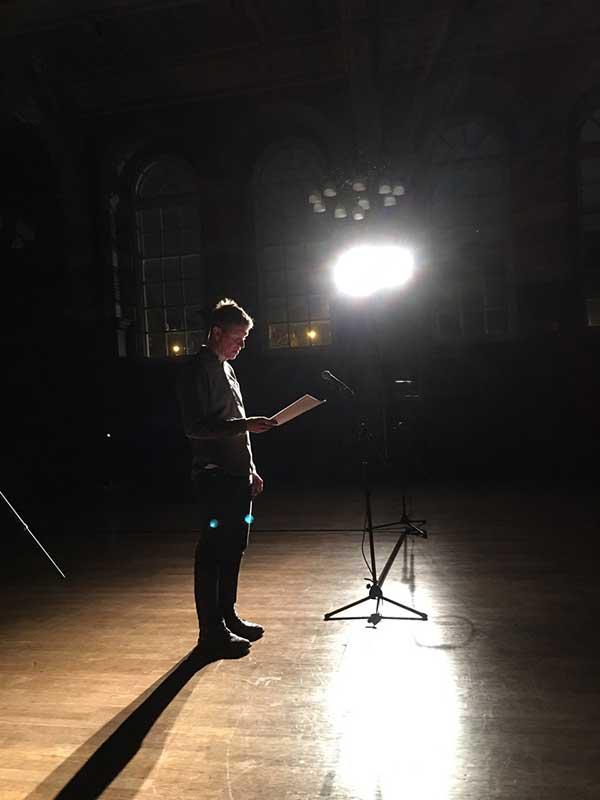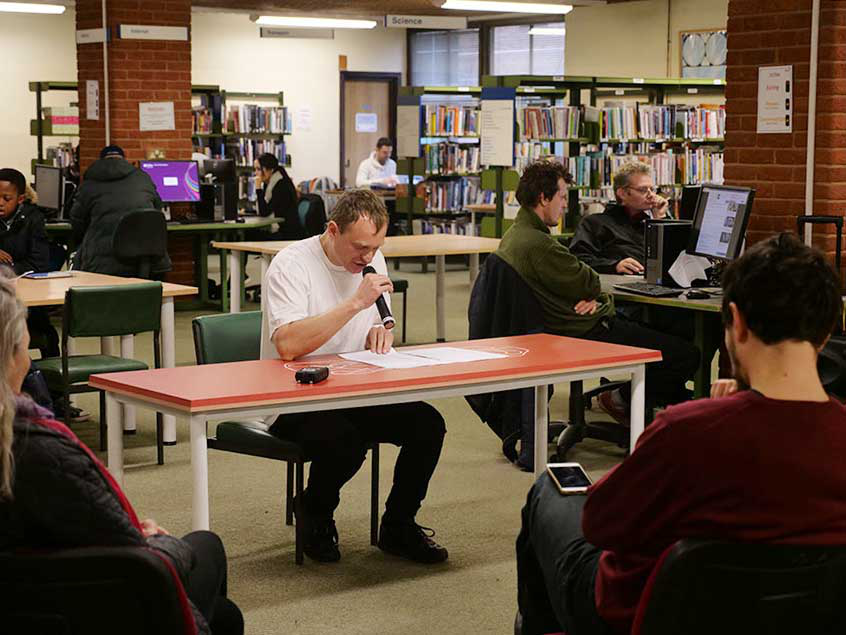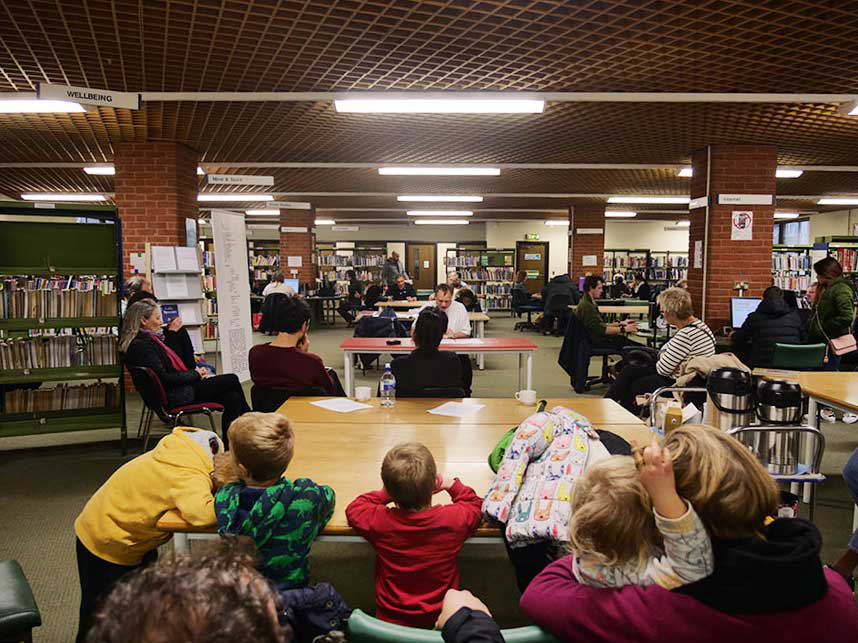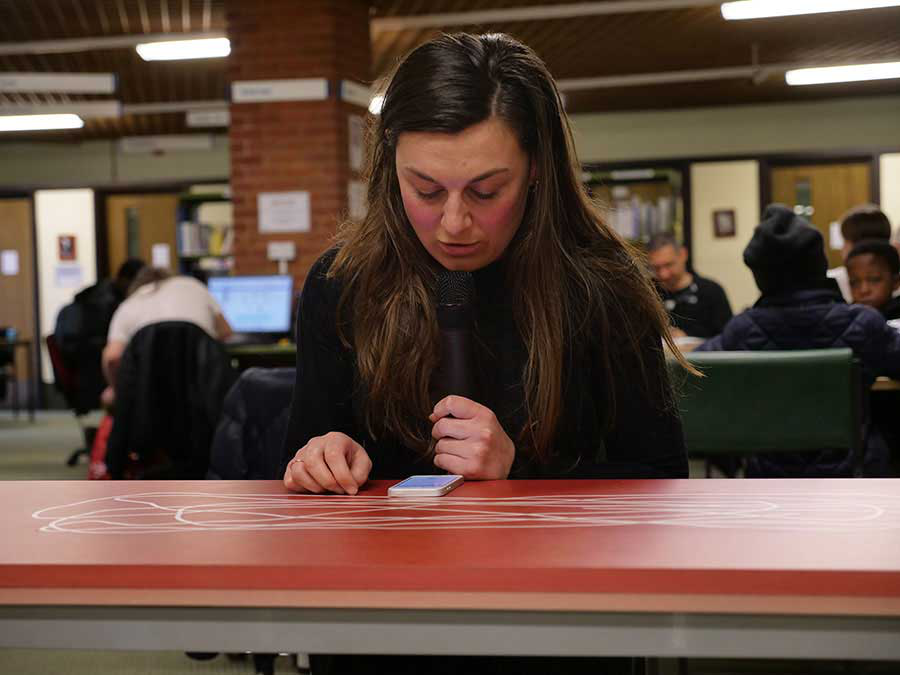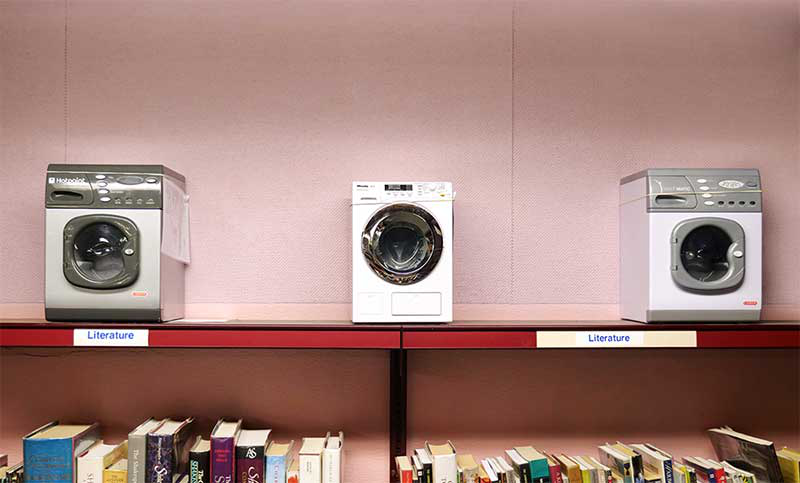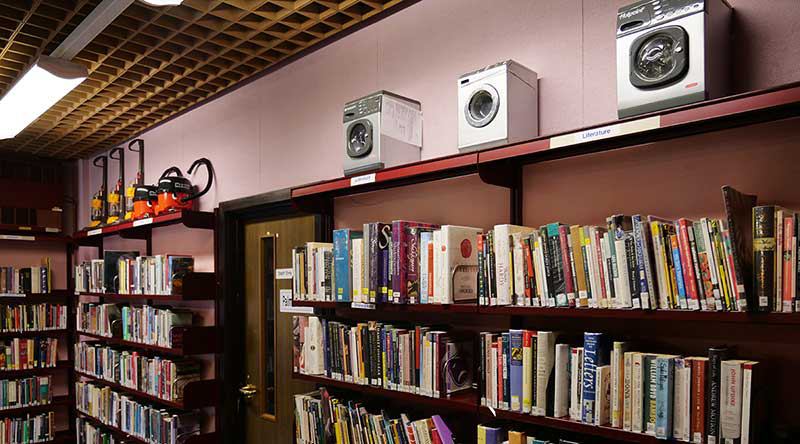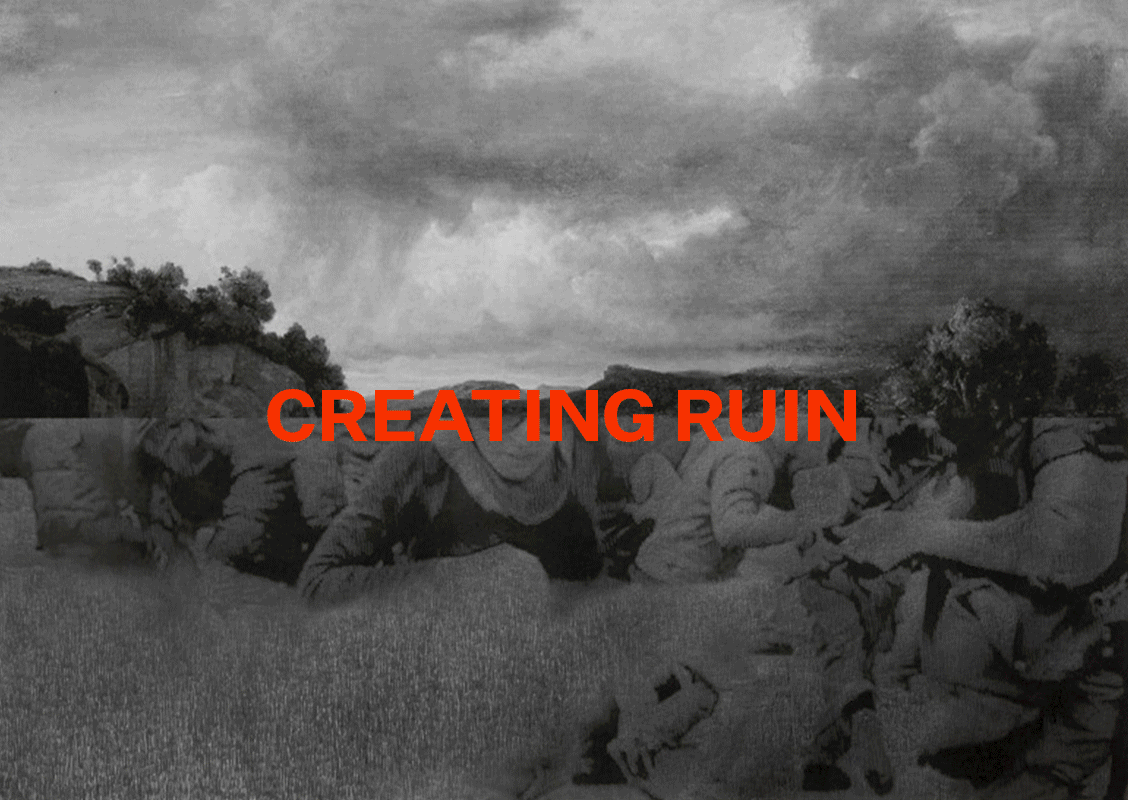3. Reading International: Curating the Art School
As part of a three year programme we have set out and invited artists and curators to create new work in response to both the art school and to the unique social and historical context of the town, and to seek new modes of engagement for students and audiences. As outlined in the first chapter each of these works/projects is hosted in turn by a different partner organisation in the town and different propositions developed in response to our questions. Each artist and participant created different links and connections to the context we offered. The following section will introduce a selection of these responses and the developing narrative. For this exposition I have chosen a series of projects out of a two-year programme that have responded to the specific context of the art school and the university. In a follow-on exposition I am planning to offer another series of example of artist responses.
3.1. The Students’ Cultural Centre Belgrade
In her talk as part of this series, entitled ‘Who is the University for? Imagine if we had a Students’ Cultural Centre’, curator Lina Dzuverovic[31] drew on a particular historical precedent of one of the best-known university-affiliated cultural centres in Europe: Belgrade's Students’ Cultural Centre (SKC), which remains active today, although no longer under the auspices of the university. The talk focused on the SKC’s inaugural programme of 1971, using it as a model to imagine such a space. Initiated by the university, but not governed or directed by it, the SCK was a space away from degree, accreditation or any academic formal structure. The SKC was established following the summer of 1968 that saw students protesting around the world, demanding active participation, democratisation and liberation. There was also pronounced protest, particularly in Belgrade, and in other larger cities, where, as Dzuverovic pointed out, students were not protesting against socialism‘ but rather they were protesting against both the elites’ gradual abuse of their power positions and the degradation of the specific revolutionary educational and cultural project, whereby culture was central to all people without class separation’. Led by politically active students at the art academies as well from other faculties, students demanded a cultural sphere as a site for emancipation, spaces for culture to be accessible to all and public space for culture and cultural activity. To their surprise after several days of occupation the government agreed to their demands and committed to securing substantial spaces of culture in the centre of three major cities. These became interdisciplinary cultural organisations, which were allocated secure infrastructural funding for salaries and programmes, and which were under the auspices of the cities’ universities. The spaces were open and available to all students and succeeded in bringing together cultural workers in these sectors, fuelled by a genuine belief in the emancipatory power of spaces of culture as active sites of action. Dzuverovic explained that artists were keen to test out the emancipatory potential of the cultural sphere featuring local artists and activities as well as international avant-garde artists who they were able to attract and invite as part of their programming.[32]
Looking at this specific historical experiment we could ask how it might function as model to see how we could think about a public space that is affiliated to a university and what it would mean to apply this model to our own local context today. We started by taking a look at the local situation during the time of student protest and explored ways to integrate this into our ongoing discussion and programming.
In 1968 students had occupied the Hornsey College of Art in London. Over the course of 1968, the college was the scene of protests when students occupied the Crouch End Hill site. Students attending the college, which originally spread over several sites, convened to discuss the withdrawal of Student Union funds and resolved to sit-in. During this period they effected a temporary administration of the college, and called for a major and consultative review of the art curriculum, supported by sympathetic academic staff and visiting artists. Some of these documents were presented as part of a project called The Hornsey Project. Hornsey achieved notoriety because of the scale of the all-night protests and sit-ins, which were copied in similar art schools around the UK. Students criticised and scrutinised the overburdening bureaucracy of education and questioned the fundamental paradigms of art schools and education generally, and demanded radical change. [33] During the six weeks that the sit-in lasted, Hornsey became the focus of debate about the method of art education and teaching in Britain.[34]
3.2. A reproduction of three weeks in May 1970
At the same time not far away in the Department of Art at the University of Reading, students were maybe less radical but were also developing a growing interest in new and critical formats, such as ‘happenings’, music, pop and fashion, and were thereby aiming to be at ‘the furthest frontiers of the musical and performative avant-garde’ as Michael Bracewell describes it in his book on Roxy Music. Some of the band members originated as art and music students in Reading and Winchester.[35] In May 1970 artist Rita Donagh who arrived from Newcastle, one of the pop cultural centres of the time, and a group of students, occupied a studio at the University of Reading. Staging events, performances and collective actions, they wrote and discussed circumstances within and beyond the confines of the university. Didactic conventions and context were replaced in an attempt to diagram a charged collective knowledge. Activated against a backdrop of student protest, in particular the Kent State massacre, the group sounded political images, registered distance and invested in a politics of time, place and bodies.[36] (Some of the student participants then developed careers as artists and musicians, such as the pop and punk band ‘The Moodies’.) Donagh’s own response, the painting ‘Reflection on Three Weeks in May 1970′ uses a social-political cartography to plot distinct events between image and experience. The painting ‘Reflection on Three Weeks in May 1970’ is now held at Tate Britain.[37]
This historical scenario was used as the catalyst for the year-long interdisciplinary curatorial project, ‘A reproduction of three weeks in May 1970’[38] organised by the itinerant curatorial and publishing platform NOVEL (Alun Rowlands and Matt Williams) who sought to activate the historical scenario as a platform for discussion and reflection, connecting the spaces of the university with public spaces of display, thereby disseminating narratives around different kinds of fiction and art writing. NOVEL uses its publishing methodology for an array of editorial and curatorial projects, publishing artists’ writing and texts that in their own words ‘oscillate between modes of fiction and poetry, thereby acting in-between the potential performance of a script, and the indeterminate transcript of the event’.[39] This curatorial methodology maps on the itinerant nature of Reading International, using its modes of dissemination and publishing as a bridge to link spaces between university and town, fictioning and re-activating a social, almost forgotten memory of the place. NOVEL’s project currently still evolves. On NOVEL’s invitation, Düsseldorf-based artist, curator and publishing collective Studio for Propositional Cinema (SPC) produced a series of Public Notices, displayed as billboard posters and posted on three extensive empty hoarding sites in Reading. The script/text describes a libretto for a five-dimensional dystopian opera set in a society in which all forms of language and interpersonal communication have been mitigated or eliminated. This script was then performed by an actor and interpreted as a musical score, which led to an organ recital by Swedish organist Hampus Lindwall, and was staged at the University of Reading’s Great Hall, which is located at the London Road Campus, close to the site where Rita Donagh’s experiment had originally taken place. Each of the six songs of the libretto represents the desperate attempts of the protagonists to relearn various forms of communication. The recital was performed to an audience of students, academics, local artists, external visitors from London and Berlin, local organ enthusiasts and community members. This event was in turn interpreted by students and the local community. A group of theatre students sought permission to use SPC’s text works as a script for their own experimental theatre project, which they developed for their performance exam. The billboard project and performance event was then reviewed by a local community blogger, who wrestled with the experimental nature of the work, but nevertheless published a personal, humorous interpretation of the event. The artist’s Berlin based gallery then promoted the work and produce a 14” record for their next international exhibition.
3.3. Creating Ruin and Method Fund
In her talk for Reading International, founding member artist Lada Nakonechna [40] introduced the Method Fund [41]as an independent, nonprofit, cultural and educational organisation in Kiev. It was established in 2015 by a group of artists, curators, art historians, architects and teachers in response to the political protest centred around Maidan in 2014. Maidan was the central square on which a day of bloodshed marked the end of a year of protest against the government of President Viktor Yanukovych, who soon afterwards fled the country. More than 50 protesters and three police officers died, and a war with Russia across border territories unfolded. The context of war, corruption and economic hardship have marked the experiences of artists and students growing up in Ukraine. Since its establishment the Method Fund functions as an experimental, self-educational project which focuses on making their art education relevant to their local context and open to all. The traditional Fine Art Academies in Ukraine are seen by many as gatekeepers for an elite, traditionalist core of artists, from which critical debate and connection to the international art discourse is kept at a distance. Operating as an art-school in parallel to the Academy of Fine Art, gathering artists and volunteer teachers, the Method Fund tests new forms of self-organisation, self-determination and collaboration, and it is a responsive mode of art education to support young artists in their specific local context and in response to current political urgencies. Since 2005 Lada Nakonechna is also a member of the REP group (Revolutionary Experimental Space), an artist-collective interested in the process of community building and in shaping a generation of politically engaged Ukrainian artists. Together with her colleagues from REP, Lada works with the social space of post-Soviet countries as a mirror of European processes, dealing with questions of personal responsibility and civic patriotism, examining the interaction of the individual and the common, and exploring the role of the artist and art institution in contemporary Ukraine. She is interested in art as a communal activity and fragile instrument for social change
In June 2018 Nakonechna spent time on a residency[42]at the University of Reading and with the Reading Abbey Ruins, and developed new online publication ‘Creating Ruin’ [43] together with London based designer Lozana Rossenova. We invited Lada Nakonechna to respond to one of Reading’s most renowned historical sites, the Reading Abbey Ruins. Reading Abbey was one of Europe’s largest royal monasteries. As ‘global’ centres or hubs of their time, the medieval abbeys acted like contemporary international corporations and were closely connected through a European network. The Abbey was first destroyed after the monastery was purged following Henry VIII’s dissolution, when the buildings of the Abbey were extensively robbed, and most parts removed were sold or used elsewhere. In the 17th century civil war raged in Reading town, during which the Abbey was destroyed. Lada Nakonechna approached the ruins as monuments to both internationalism and secularisation. She focused on picking up some flint stones which resembled in size and feel those paving stones that were lifted from the streets, not only during student protests in Paris, but also to a large extent during the protest in Kiev’s Maidan. Her project took two different avenues: she collected stones and re-produced them as plaster casts and at the same time she developed a new online publication. The project was first presented during a week-long event at the Abbey Gateway. During this time Nakonechna led two drawing workshops [44] for student and community audiences, where participants were invited to contribute to the development of the work through a series of drawing exercises on the Abbey site, and to take part in a series of conversations and discussions around what it means to ‘create ruin’. The online publication by Method Fund was developed in collaboration with designer and researcher Lozana Rossenova to create a communal approach to building digital archives. Lozana led a software workshop [45] during which participants were introduced to the online tool Webrecorder developed by New York based arts organisation Rhizome, and learned to create personal online archives and to contribute to the publication. Throughout this process the artist was assisted by a group of student assistants from the Reading School of Art. In the following months we organised an online programme of video works,[46] which demonstrated different states of ‘ruin’, showing fragments of lives in contemporary Ukraine, where everyday relations, war, and mass manipulation have become inseparable and the rhetoric of capitalism is fused with that of national heritage.[47]
3.4. The SUPERSTRUCTURE
Another example of how through careful placement and programming we have started an ongoing conversation with both the local and international community can be seen in a project that London and Brussels based artist Ghislaine Leung developed from a six-month project staged at the local Reading Central Library. For ‘reading in Reading’, artists David Raymond Conroy, Ghislaine Leung, Cally Spooner and Jesper List Thomsen[48], were invited to respond to the hosting institution, the Reading Central Library through the use of various narrative structures. The artist, on working in the library, became acutely aware of the difficult and sensitive situation of council-run libraries in times of austerity and council cuts to libraries and their services, and as has been experienced in Reading, where opening hours, events and stock have been drastically reduced. This is happening a the same time as the University of Reading is investing into the university library, refurbishing, and re-stocking resources. Collectively the artists created and wrote what they named a ‘SUPERSTRUCTURE’, a framing device which hosted the group’s activities and operated as a tool to devise a number of expanded readings, events which took place over the course of six months. The ‘Superstructure’ launched Reading Central Library’s external amphitheatre, performed by a group of teenagers from a local drama group following a workshop with the artists and published in the local newspaper Reading Chronicle.[49] Over the course of six months, artist Cally Spooner worked with the teenagers again to create a jingle for the local library, which was produced and broadcast by local TV station BBC Radio Berkshire and played once a day at the library, as an ‘intangible’ public artwork and a practical advertisement for library services. Jesper List Thomsen spent time in residence at the Reading School of Art and worked with students to create a new painting and public artwork, installed as a tabletop in Reading Central Library, replacing an existing top for a 12-week duration. The painting/table played host to a series of readings by the group of artists over the course of the project, but also functioned as a table in the day-to-day life of the library. The project of Local Studies artist Ghislaine Leung was installed on the first and second floors of the Central Library, and featured duplicate materials from Reading’s Toy Library, Audio and Reference Collections, which were presented on library furniture. In order to borrow materials from the Toy Library for the exhibition’s duration, new toys were bought to replace and add to the loaned ones, which then entered into the library’s collection after exhibition. These materials collectively formed a new work by Leung, ‘Public Sculpture’, which became available for exhibition loan from the Toy Library after the closing of the exhibition, as well as each individual toy being available for standard library loan. A unique catalogue publication by Leung is being developed in collaboration with students from the University of Reading following a writing workshop and including photos of the exhibition to be made available for reference only in the Local Studies Collection after the exhibition. Following the exhibition and subsequent reviews,[50] Ghislaine promoted the project to a number of international exhibition projects. Most notably, ‘Public Sculpture’ was loaned by Fri Art, Centre d’Art Contemporain, Fribourg[51] for an exhibition that addressed ‘working conditions, hierarchies, security, the authority of institutions, that of a position, status, solidarity, injustice, precariousness, circulations, endangerment, deconstruction, manipulation, flight, submission, independence, power or again representation’.[52] Public Sculpture was loaned by the gallery for an exhibition fee of £300 paid to the library, thus enabling the gallery to produce a small income.[53] As Library manager Simon Smith confirmed, this comparably small amount makes a difference to the library. [54]
‘Ghislaine Leung, Public Sculpture, 2018. Toy Catalog Items, laminated and paper labels, rubber bands. The support of a "service" takes shape in the work Public Sculpture (2018), commissioned by Reading International for Reading Library. To obtain this piece, Fri Art was asked to activate the loan system introduced by Ghislaine Leung (*1980, London) with the library in Reading, England. Public Sculpture's toys, purchased by the artist for this commission, exist in two borrowing terms, depending on whether they are loaned individually by the library, and according to whether they are borrowed to incorporate an art exhibition. They thus retain a dual status, and assume both the attributes of a library loan and that of an exhibition; borrowed, packaged, transported, insured, exhibited, listed, titled. The development of this complex mechanism is at the heart of this work. At the end of the exhibition, the objects return to the library and are available for a new loan.’ [55]
[31] Lina Dzuverovic, ‘Who is the University for? Imagine if we had a Students’ Cultural Centre’, Reading International Talk #5, 8 January 2018.
[32] Lina Dzuverovic, ‘Who is the University for? Imagine if we had a Students’ Cultural Centre’, Reading International Talk #5, 8 January 2018.
[33] ‘. BFI Player. Retrieved 2018-06-1.https://player.bfi.org.uk/free/film/watch-the-hornsey-film-1970-online
[35] Bracewell, Michael, Re-make/Re-model: Becoming Roxy Music, 2007, Da Capo Press Inc, 320 pp
[36] Reading International ‘A reproduction of three weeks in May 1970’ organised by NOVEL https://readinginternational.org/programme/a-reproduction-of-three-weeks-in-may-1970-organised-by-novel/
[37] Published in The Tate Gallery Report 1972–1974, London 1975. Tate Website, Catalogue entry, https://www.tate.org.uk/art/artworks/rita-reflection-on-three-weeks-in-may-1970-t01687
[38] RI: ‘A reproduction of three weeks in May 1970’ organised by NOVEL https://readinginternational.org/programme/a-reproduction-of-three-weeks-in-may-1970-organised-by-novel/
[39] NOVEL website www.novelnovel.org
[40] Reading International: Lada Nakonechna Talk, Method Fund https://readinginternational.org/programme/ri-talk-lada-nakonechna/
[41] The Method Fund website http://www.methodfund.org
[43] Creating Ruin website: www.readinginternational.org
[44] RI: Lada Nakonechna Drawing Workshop https://readinginternational.org/programme/creating-ruin-drawing-workshops-at-the-abbey-ruins-with-lada-nakonechna/
[45] RI: Lozana Rossenova, Webrecorder Workshop https://readinginternational.org/programme/webrecorder-web-archiving-for-all-workshop-with-lozana-rossenova/
[46] RI: Creating Ruin-Online Screenings https://readinginternational.org/programme/ri-video-online-video-screenings/
[47] RI: Favourite Places, Interview with Lada Nakonechna by Susanne Clausen, https://readinginternational.org/programme/ri-video-favorite-places-ivan-melnychuk-gruppa-predmetov/
[48] RI: reading in Reading webpages https://readinginternational.org/programme/reading-in-reading/
[49] RI: The SUPERSTUCTURE is published in the Reading Chronicle, https://readinginternational.org/programme/reading-reading-superstructure-published-reading-chronicle/
[50] Ghislaine Leung and Reading International, Contemporary Art Daily https://www.contemporaryartdaily.com/2018/04/ghislaine-leung-at-reading-international/
[51] ‘October 12 – November 25, 2018’ at Fri Art, Centre d’art Fribourg
http://www.fri-art.ch/fr/expositions/october-12-november-25-2018
[52] ‘October 12 – November 25, 2018’ at Fri Art, Centre d’art Fribourg
http://www.fri-art.ch/fr/expositions/october-12-november-25-2018
[53] Exhibition Guide ‘October 12 – November 25, 2018’ at Fri Art, Centre d’art Fribourg
http://www.fri-art.ch/sites/default/files/2018-11/FR_guide.pdf
[54] Email by library manager Simon Smith to the author, 1 March 2018
[55] ‘October 12 – November 25, 2018’ at Fri Art, Centre d’art Fribourg
http://www.fri-art.ch/fr/expositions/october-12-november-25-2018
‘Redundant as eyelids in absence of light’, organ recital, by Studio for Propositional Cinema, Reading International, 2018
